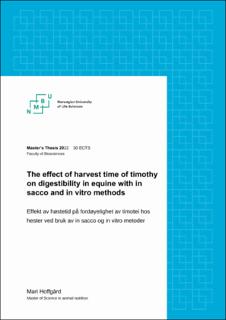| dc.description.abstract | The objective of the present thesis was to investigate how harvest time influence digestibility in horses, in addition, to compare three different methods evaluating digestibility. Timothy grass was harvested eight times during the summer of 2021 and analyzed for chemical and sugar composition. The techniques used to measure of digestibility were the in sacco (IS) and two in vitro methods: daisy incubation (DI) and gas production (GP). Forage is the most essential feedstuff in the equine diet. While excessive intake of sugars is associated with metabolic disorders, fiber is essential for the hindgut microbiota. A late harvest time ensures a high fiber content while compromising digestibility and nutritional value. The reference method of determining digestibility is the in vivo technique. Unfortunately, in vivo techniques are time-consuming and expensive to operate. In the IS method, feedstuff is placed in small bags for incubation in the horse’s hindgut. The in vitro methods DI and GP, include incubating a feedstuff with a buffer solution and inoculum (cecal fluid) in different apparatuses. The GP method also records gas production provided by microbes fermenting carbohydrates. The digestibility is eventually calculated based on the amount of feed disappearing during incubation. Chemical analysis showed a decrease in crude protein (CP) and ash and an increase in neutral detergent fiber on an organic matter basis (NDFom), acid detergent fiber on an organic matter basis (ADFom) and acid detergent lignin on an organic matter basis (ADLom) from early to late harvest, as evidence of progressive maturity in the grass. Further, water-soluble carbohydrates (WSC) content was high, low and thereafter high in early, middle, and late harvest, respectively. Fructan content was high in late harvest time. All digestibility methods showed a linear decrease in dry matter (DM) digestibility with postponed harvest time, and they were highly correlated. However, the methods showed differences for digestibility estimates, where IS gave the highest values, followed by GP and thereafter DI. Practical recommendations generated through this study are that early harvest is suitable for horses with high protein and energy requirements. Middle harvest time is recommended for horses prone to laminitis, insulin resistance or overweight to avoid high sugar content. For leisure horses, a middle and late harvest time are suitable. All methods have been evaluated as valuable methods to quantify forage digestibility in horses. Furthermore, IS is the recommended method as it is most similar to the actual biological occasion. However, cannulated horses are rare. Therefore, the GP and DI methods are good alternatives. | en_US |

